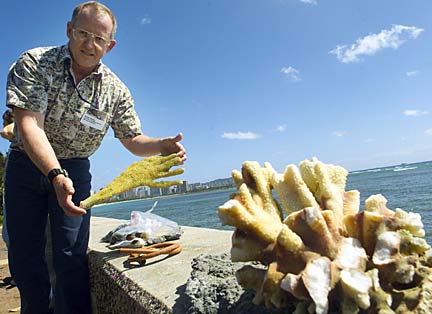
|
Extensive reef damage
found from stricken ship
Biologists assess the destruction
of coral off Barbers Point
Damage to the coral reef where the Cape Flattery was stuck for nine days could be the most extensive from a ship grounding ever in Hawaii, biologists said yesterday.
The area where the 555-foot bulk cargo ship was grounded 400 yards from Barbers Point Harbor was "flattened," said Steve Kolinski, a National Marine Fisheries Service coral reef ecologist.
In addition, broken-off chunks of coral and globs of hardened cement underwater could continue to damage the remaining healthy reef when waves move them around, Kolinski said.
A coalition of scientists and divers from the Fisheries Service, U.S. Fish and Wildlife Service and state Department of Land and Natural Resources will document the extent of the damage and do what they can to repair it during the next few weeks, they said yesterday.

At a press conference yesterday, Kevin Foster, a coral biologist with the U.S. Fish and Wildlife Service, displayed examples of coral knocked loose after the cargo ship Cape Flattery ran aground off Barbers Point Harbor on Feb. 2.
"Not every colony can be addressed, but we'll do what we can," said Kolinski, who will head up the restoration work.
Scientists will experiment with different kinds of adhesives to see which one is most effective.
Another concern is the possibility that the areas of damaged reef could be susceptible to being overgrown by an alien algae, said Kevin Foster, a Fish and Wildlife Service coral biologist.
"We hold coral reef resources in very high regard. They're the basis for the marine ecosystem in Hawaii," Foster said after being asked how he felt about the damage. "It's a tough experience to go through, but we're biologists. We take a clinical approach to this."
Detailed mapping and photos of the damage will allow scientists to monitor the reef's recovery over time, said Dave Gulko, a state DLNR coral biologist.
Two species of coral are affected, cauliflower and lobe coral, in waters ranging from 24 to 90 feet deep, Foster said.
The Cape Flattery ran aground on Feb. 2 outside the entrance to Barbers Point Harbor. About one-third of its load of bulk cement and most of the ship's fuel were removed before the boat was refloated early Friday.
There were no fuel spills, but significant quantities of granular cement were spilled into the ocean as a crane and barge offloaded it to get the ship off the reef.
The Hong Kong-flagged Cape Flattery is managed by Pacific Basin Shipping HK Ltd. The cause of the grounding remains under investigation by the Coast Guard.
[News] [Business] [Features] [Sports] [Editorial] [Do It Electric!]
[Classified Ads] [Search] [Subscribe] [Info] [Letter to Editor]
[Feedback]
